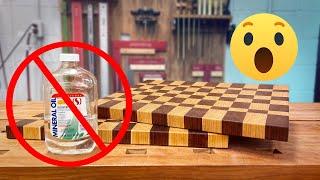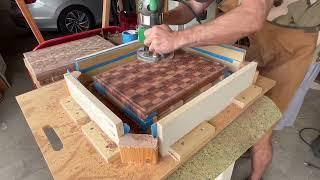
Stop Using Mineral Oil for Cutting Boards and Utensils!
Комментарии:

Polymerization can be a continuous process and be quantitated by a term called degree of polymerization (DP). At lower DP you can have thin liquid which will get thicker as the DP goes higher.
Not all solve ts are dangerous, in fact, water is a solvent, for example. I dissolve some polymers with water.

Interesting video on a confusing topic. No product prevents board movement like warping. In dry environments no oil can replace wood moisture loss. End grain cutting boards seem to be the only stable board products. I have found the only board treatment for functionality is to use a food oil to give color to the board and when dry I rub the entire food surface with a block of hard parafin wax. I then take a heat gun on low or a hair dryer and melt the hard wax and while liquid I spread and level the wax with a 6" paint scraper. I repeat the process several times to build up a hard usable surface. When needed I use the heat gun and paint scraper to melt the old bits of wax and add new wax as described above. Works quite well and no more expensive and functionally useless commercial products. This might be heresy but it works long term.
Ответить
Hi Marc, That was a very helpful video. I’m a beekeeper and sometimes woodworker, and I’ve wondered about finishes and in fact in the process of figuring out the best choice for a current project. You basically answered every question I have. And I’m sticking with tung oil and beeswax. It has been a very durable finish and is easy to apply and seems to hardness up just as “advertised.” I like the fact that you also use Citrusol solvent answered another question I’d been considering. Thanks!!!
Ответить
Apparently, you are old enough to use the word "groty". Welcome to the club.
Ответить
All this is great advice but i gotta stick with mineral oil even if it takes maintenance. I can give people gifts and know one hundred percent it wont go rancid.
Ответить
The my use siccative to increase the polymerization rate. Some kind of metal salt most of the time. Polymerization occurs with exposure to oxygen, won't happen in the can.
Ответить
Not sure if you mentioned it or it's listed in the comments but what's a good ratio of tung oil and nature's orange when mixing together for finishing?
Ответить
If a company doesn't want to tell you what's in it you can ask for an msds data sheet.
Ответить
What ratio do you use of the tung oil & natures orange?
Ответить
So your primary concern in a FOOD SAFE FINISH is "water resistance"?????? How bout how food safe it is??? Maybe that should be at the top.
Ответить
I was given a 50/50 mix of Tung oil and citrus solvent by a woodworker friend. He learned it from this video. I just used it yesterday and it looks and feels amazing! My question is, do I do another coat today? I usually use Tung and mineral spirits for the first coat. Then pure tung the second coat (after 24 hours) What’s your take?
Also, this video was great and helpful. Thank you!

Great compare & contrast review. Thanks for doing this!
Ответить
Tung oil is made from nuts, so you can unintentionally and unknowingly expose someone with nut allergies to a deadly toxin if you use on a cutting board. Might be okay for things like furniture or other wood products, but I don’t think I’d recommend using it for food.
Ответить
Just use a mix of beeswax and mineral oil.
Ответить
From a knife guy’s perspective, mineral oil and beeswax will do nothing to dull or deform a fine knife edge. Because they are non-drying, mineral oil and/or beeswax would make it more likely that the edge will cut between the upright end grains and the surface more likely to remain “self-healing”. I haven’t done any testing with tung oil, but wonder if by drying/hardening, it would reduce or eliminate any or all of the desirable characteristics listed above?
Ответить
Can I use tung oil without using a solvents or can I use beeswax instead of thinner?
Ответить
Can Tung oil be applied on a cutting board that was previously mineral oiled? Old dry boards not freshly oiled.
Ответить
What ratio of Tung Oil and Orange Solvent do you use?
Ответить
I use beeswax and mineral oil homemade mixture. It woks great, looks great, is safe, lasts, and is easy to reapply, easy to make.
Ответить
There are two important things mineral oil is good for in the kitchen. The first is wood, and the second is metal. In both applications, be sure to use mineral oil that's marked "food-grade"—you don't want to eat nasty additives that can be found in other types of mineral oil. Beware of you tube videos because they frequently have totally incorrect information NOT based on real science and chemistry. Just become someone uses a certain product does not in any way mean that they know the actual science.
Ответить

























